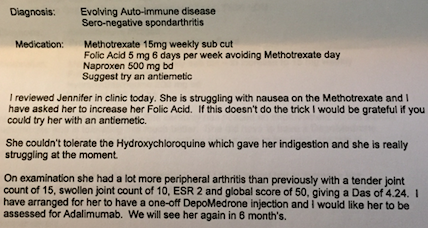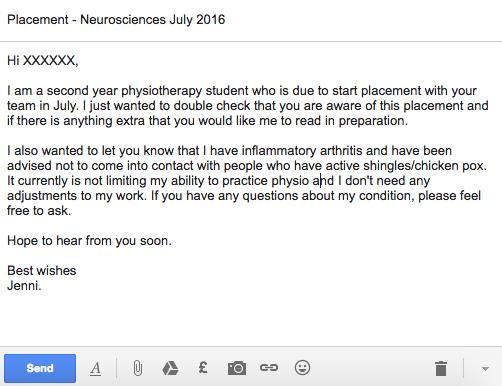What happens at biologics clinic for Ankylosing Spondylitis - a patient's perspective
Yesterday I finished my last day of University and I am officially a graduand until my graduation in July, and what better way to celebrate than learning how to inject a biological medication for the first time... Obviously I am joking but I do feel like this might be the turning point in my arthritis, which a welcomed change!
I said in my last post that I wanted to write a post about what happens at a biologics clinic for arthritis because I honestly couldn't find much information from the point of view of a patient and being slightly OCD, I quite like knowing what might happen. But please note this is my experience, and the process at your hospital may be different.
First things first, I was referred to my hospitals biologics clinic because my arthritis was not controlled on methotrexate alone and the other DMARD (hydroxychloroquine) I had tried had given me a lot of heartburn so I'd stopped it. This means that from a peripheral joint perspective, my arthritis was active enough to be considered for biologics and I met the NICE criteria for Psoriatic Arthritis/peripheral spondyloarthritis as I had also tried two DMARDs first. I also met the NICE criteria for biologics in Ankylosing Spondylitis (AS) because I have been on three different types of NSAID and my axial symptoms were still not controlled. This meant that I could be fast tracked for biologics using the AS criteria.
I said in my last post that I wanted to write a post about what happens at a biologics clinic for arthritis because I honestly couldn't find much information from the point of view of a patient and being slightly OCD, I quite like knowing what might happen. But please note this is my experience, and the process at your hospital may be different.
First things first, I was referred to my hospitals biologics clinic because my arthritis was not controlled on methotrexate alone and the other DMARD (hydroxychloroquine) I had tried had given me a lot of heartburn so I'd stopped it. This means that from a peripheral joint perspective, my arthritis was active enough to be considered for biologics and I met the NICE criteria for Psoriatic Arthritis/peripheral spondyloarthritis as I had also tried two DMARDs first. I also met the NICE criteria for biologics in Ankylosing Spondylitis (AS) because I have been on three different types of NSAID and my axial symptoms were still not controlled. This meant that I could be fast tracked for biologics using the AS criteria.
(A copy of my most recent Rheumatology clinic letter)
My biologics clinic appointment occurred about 3 weeks after my rheumatology clinic where my consultant decided to add a biologic called Adalimumab (brand name Humira). This is one of the first line biologics used and is a type of anti-TNF biologic meaning it suppresses a particular part of the immune system called the Tumour Necrosis Factor (TNF) which, can contribute to inflammation.
I met my biologics nurse who explained that the first appointment would be an assessment for whether I qualified for Humira using the AS criteria. This meant that I had to fill out four questionnaires including a question about how painful my spinal pain is on a score of 1 to 10, a BASDAI questionnaire which measures how active the Ankylosing Spondylitis is and BASFI which is how much Ankylosing Spondylitis affects things you do on a day to day basis. In order to be considered for biologics you need to have spinal pain of at least 4/10 and a BASDAI score of at least 4.
(A copy of my biologics assessment scores)
As you can see, my BASDAI was a lot higher than 4 at 5.2 as this doesn't only take into account spinal scores but also any pain caused by enthesitis (where tendons and ligaments attach to bones), pain at peripheral joints and length and intensity of morning stiffness. So even though my spinal pain score was only 4 out of 10, you can see how my peripheral arthritis and enthesitis influenced my BASDAI score to be higher than if it only assessed my spinal symptoms.
After I had filled out these questionnaires and my results were reviewed by my biologics nurse, I was informed that I did qualify for Humira. We then had to go through a process of checking that I had no obvious contraindications to Humira which included asking about my exposure to Tuberculosis, if I had any personal or family history of multiple sclerosis or other neurological conditions, if I have any chest or breathing problems, if I have a personal history of cancer, if I had ever had chicken pox, if I had any heart conditions and other such questions. I was then shown how to inject humira using a pen and a syringe and then I chose the syringe. We went through the potential side effects of humira, how to store humira (in a fridge between 2 and 8 degrees), and how often to have the flu and pneumonia vaccines. I was then sent off for bloods to look at my inflammatory levels, my immunity to chicken pox/shingles and to check for TB exposure. I then had to have a chest x-ray as a precaution to check for TB also. I was also given an information pack on joining a biologics registry to help the British Society for Rheumatology understand how well biologics work for AS and to identify any side effects. I have an appointment to join that registry next week.
As part of the appointment I was also able to ask questions, and especially as someone who is going into work in the health sector, I had A LOT of questions, which my biologics nurse graciously answered:
(Copy of the questions I took to my biologics appointment)
All in all the appointment took about an hour an a half including the bloods and the x-ray. I think that sums up everything that happened in my biologics clinic appointment quite nicely. Obviously, for people being assessed for RA or PsA you won't have to do the BASDAI or BASFI questionnaires but you may have to do questionnaires and have your joints re-assessed but as I have no experience of this, I can't say anything for sure. The advice I would give is to go into the appointment with a list of questions as it is an excellent opportunity to ask a specialist in biologics anything that concerns you or you would like more information on, and that applies to anyone being assessed for biologics whether for a rheumatological condition or dermatological, GI or respiratory condition. I hope this helps to remove some of the uncertainty surrounding what actually happens at your first appointment!




Comments
Post a Comment